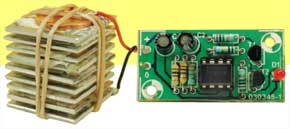Cuk Converter
-

The operating principle of the Cuk Converter avoids the need for particularly exotic components. That means we can right away take the plunge with a ‘heavy-duty’ dc converter, which is ideal for use with fluctuating energy sources such as solar systems.
The Cuk Converter1 topology yields a theoretically infinite variety of currents and voltages. Consequently, all relevant parameters must be monitored, and conditions that could destroy the semiconductor devices used in the circuit must be avoided. The important parameters are the input current, the output voltage and the output current. Figure 1 shows how these quantities are measured. The voltage across the source resistor of the switching transistor (R1) is used to limit the input current ii and set the short-circuit protection level. The output voltage Uo is regulated by monitoring the voltage Uon obtained using voltage divider R3/R4, and the output current io is measured by simply inserting a sense resistor (R2) in the output lead.
This is a MEMBER ONLY article. You need a subscription to read this article.
- Access to Elektor archive and 5,000+ Gerber files
- Receive up to 8 magazines per year (digital and/or paper)
- 10% discount in the Elektor store
Available from €4.95 per month.
What is Members Only
Elektor is committed to providing high-quality content on electronics, catering to tens of thousands of paying members. As part of this commitment, Elektor has launched Premium, an initiative that offers exclusive online articles to members sometimes even before they appear in the magazine.
Every day, members can access in-depth articles that showcase the best of Elektor's premium content.
This initiative aims to reward members with early access. Once logged in, members can easily enjoy this exclusive content and engage in discussions about featured projects. While Premium adds to the existing resources available, Elektor will continue to provide a wealth of free information.
Join the Elektor community today to take advantage of Premium and other benefits!
Materials
Gerber file
CAM/CAD data for the PCB referred to in this article is available as a Gerber file. Elektor GREEN and GOLD members can exclusively download these files for free as part of their membership. Gerber files allow a PCB to be produced on an appropriate device available locally, or through an online PCB manufacturing service.
Elektor recommends the Elektor PCB Service service from its business partner Eurocircuits or AISLER as the best services for its own prototypes and volume production.
The use of our Gerber files is provided under a modified Creative Commons license. Creative Commons offers authors, scientists, educators and other creatives the freedom to handle their copyright in a more free way without losing their ownership.
Component list
R3 = 0Ohm 01 3W horizontal
R4,R5 = 68kOhm
R6 = 56kOhm
R7,R9,R10,R12,R13,R16,R17,R18,R20,R24,R33,R36 = 10kOhm
R8 = 0Ohm 1 3W horizontal
R11,R19,R31 = 1kOhm
R14,R15 = 100kOhm
R21,R34,R35 = 220kOhm
R22 = 47kOhm
R23,R25,R26,R30 = 4kOhm 7
R27 = 100Ohm
R28 = 3kOhm 3
R29 = 12Ohm
R32 = 6kOhm 8
P1,P2 = 10kOhm mono potentiometer
P3,P4 = 100kOhm preset
Capacitors:
C1,C2 = 10,000µF, 50V radial, o 30mm, lead pitch 10mm
C3-C6 = 10µF, 250V MKT, 18x31.5mm, lead pitch 27.5mm (Vishay 373)
C7 = 1000µF 250V radial
C8-C12,C20-C23 = 220nF
C13,C19,C32 = 22µF 40V radial
C14,C16 = 10µF 63 V radial
C15,C17 = 10nF
C18 = 3nF3
C26,C28,C29 = 100nF
C30,C31 = 470µF 25V radial
C33,C34,C35 = 1nF
Semiconductors:
D1,D2 = DSEP60-06A (Ixys)
D3-D7,D10,D11,D14,D15 = 1N4148
D8 = LED, green, low current
D9 = LED, yellow, low current
IC1,IC2 = TL074
IC3 = UC3526 (TI) or SG3526 (ST)
IC4 = LM393
IC5 = 7818 with clip-on heatsink
T1,T2 = IXFK90N30 (Ixys)
T3,T5,T7,T8 = BC639
T4,T6 = BC640
Miscellaneous:
S1 = pushbutton and/or thermal fuse or PTC
TR1 = E42/21/20 core with coil former and mounting clamp (standard stock item from RS Electronics)
1m 1mm2 RF litz wire, or 1mm2 enamelled copper wire
Heatsink <1K/W (<0.35K/W when thermal fuse not triggered)
PCB, order code 030346-1 (see Readers Services page or website)
Leave open:
C24 = 470µF, 35V radial
C25 = 470µF, 40V radial
C27 = 100nF
D12,D14 = 1N4007
IC6 = 7915
Not on PCB:
B1 = bridge rectifier 100V piv, 35A (secure to heatsink)
C36 = 10,000µF, 50V radial (additional ripple reduction at direct voltages below 35V)
TR2 = mains transformer, 24V, 20A
F1 = Fuse, 2.5AT (slow) with fuse holder
S2 = double pole mains on/off switch for Tr2



Discussion (0 comments)